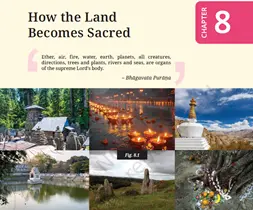Chapter 8 "How the Land Becomes Sacred" Extra Questions or In Text Questions Class 7-Subject Social Science

Q1. What is ‘sacredness’?
- Sacredness means deep spiritual or religious importance.
- It may be a place, object, or journey that is holy or respected.
- In India, sacredness includes not just religion but also geography and tradition.
- Sacred places evoke emotions like devotion and reverence.
Q2. How does the land become sacred?
- Through connection with gods, saints, or important events.
- Places where divine acts happened are considered holy.
- Natural elements like rivers, hills, and forests are worshipped.
- Sacredness is passed down through stories, rituals, and beliefs.
Q3. How do sacred sites and pilgrimage networks connect with the life and culture of the people?
- People take pilgrimages (tīrthayātrās) as part of their religious life.
- Pilgrimage routes help share languages, food, and customs.
- Sacred places become centers for festivals, music, and traditions.
- These sites link different communities across India.
Q4. What role did sacred geography play in the cultural integration of the Indian Subcontinent?
- Pilgrimage routes crossed India from north to south and east to west.
- People from different regions interacted during pilgrimages.
- They exchanged stories, trade, and religious beliefs.
- This helped build a shared Indian identity and unity in diversity.
Intext:
Q5. Read the excerpt. What are your observations? Locate the route the group must have taken from Rameswaram to Haridwar. Why do you think the group was going straight to Haridwar instead of stopping at Delhi?
- The group was committed to their pilgrimage, showing dedication.
- They carried all food and supplies, showing preparation.
- They didn’t stop at Delhi because their next sacred stop was Haridwar.
- The journey had spiritual discipline—they avoided distractions.
Q6 In ancient times, when people were travelling from
Madurai in Tamil Nadu to Varanasi in Uttar Pradesh, what languages would they come across? How would they communicate with people in those places? Where would they stay? What food would they eat?
Answer: In ancient times, travelling from Madurai to Varanasi:
- Travellers crossed many language zones: Tamil, Telugu, Kannada, Marathi, Hindi.
- Communication happened using gestures, shared words, and local helpers.
- They stayed in dharmashalas or temples along the route.
- Food included local grains, fruits, and offerings from temple kitchens.
Q7. Note the locations of the chār dhām. What do you think it implied for the people when they travelled north-south and east-west?
Answer:
- It meant covering all four corners of India: North (Badrinath), South (Rameswaram), East (Puri), West (Dwarka).
- Pilgrims experienced India’s diversity and unity.
- It helped people understand different cultures and faiths.
- It encouraged respect for all regions as equally sacred.
More In Text:
Q8 Can you identify the names of a few traditional tīrthas given in the map above? You can refer to the political map at the end of the book for help.
Answer:
- Badrinath (Uttarakhand)
- Rameswaram (Tamil Nadu)
- Puri (Odisha)
- Dwarka (Gujarat)
- Varanasi, Amarnath, Sabarimala, and Prayagraj
Q9. How do you think these sacred places are connected with the people’s economic lives and activities? Draw a mind map to trace these connections. (Hint: The pictures 8.7 AND 8.8 above can provide some clues.)
Answer: (Mind Map Points)
- Pilgrims need food, clothes, transport → supports local businesses.
- Local markets grow near temples.
- Craftsmen sell souvenirs and religious items.
- Hotels, dharmashalas, and guides earn from visitors.
- Festivals attract huge crowds → boosts economy.
Q10. Given below are the names of a few sacred groves in a few regional languages of India. Can you add to this?

Answer:
Assam (Additional) – Deosal
Odisha (Additional) – Jahira
West Bengal (Additional) – Harith Ban
To Learn More In Text Questions Click Below:
Chapter 3- Climates of India
Chapter 4- New Beginnings: Cities and States
Chapter 5-The Rise of Empires
Chapter 6- The Age of Reorganisation
Chapter 7- The Gupta Era: An Age of Tireless Creativity
Chapter 8- How the Land Becomes Sacred
**************************************
MCQs:
Chapter 1- Geographical Diversity of India
Chapter 2- Understanding the Weather
Chapter 3- Climates of India
Chapter 4- New Beginnings: Cities and States
Chapter 5- The Rise of Empires
Chapter 6- The Age of Reorganisation
Chapter 7 – The Gupta Era: An Age of Tireless Creativity
Chapter 8- How the Land Becomes Sacred
**************************************
NCERT Solutions:
Chapter 1- Geographical Diversity of India
Chapter 2- Understanding the Weather
Chapter 3- Climates of India
Chapter 4- New Beginnings: Cities and States
Chapter 5–The Rise of Empires
Chapter 6- The Age of Reorganisation
Chapter 7 – The Gupta Era: An Age of Tireless Creativity
Chapter 8- How the Land Becomes Sacred
Pingback: In Text Questions-Chapter 12-Understanding Markets Class 7